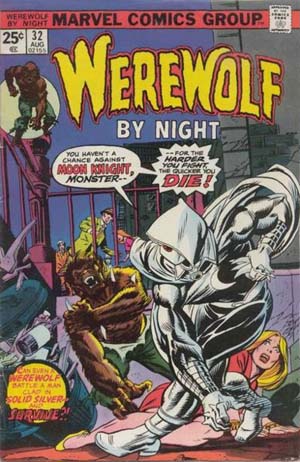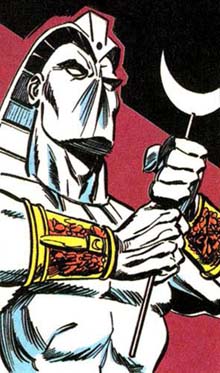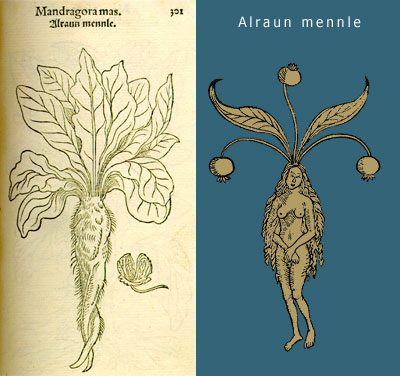 Today, the FBU is proud to present another Bronze Age Spotlight article from Trey Causey. ~ Jim
Today, the FBU is proud to present another Bronze Age Spotlight article from Trey Causey. ~ JimSHADOWS IN THE MOON
He’s often derided as a Batman rip-off. Jim Kreuger points out he’s another Jew schlepping for an Egyptian, pre-Exodus-style. People can’t even see to agree on what color his costume is (google it, if you don’t believe me).
Still, there’s something appealing about him. He’s had three on-going series, and three limited series—not bad for a guy who began as a bit player in werewolf comic. He’s even been an Avenger, if only on the west coast. His profile in the Marvel Universe waxes and wanes, but he always rises again.
So let’s trace his path, catalog his phases, and illuminate what lies on the dark side of the Moon Knight.
“Can even a werewolf battle a man clad in solid silver—and survive?!”
This was the question posed to prospective purchasers by the cover of Werewolf by Night #32, Moon Knight’s first appearance. It was presumably somewhat rhetorical since it didn’t share the cover with the legend “LAST ISSUE.” The cover date was August, 1975—which also saw the first appearance of the new X-Men in their regular title.
Moon Knight is presented as a tough-talking (in that unique mid-seventies Marvel, comics code-approved way) mercenary hired by the Committee to bring in a real-live werewolf. He succeeds, but eventually develops an acute case of conscience and helps the werewolf escape. It was not the most auspicious of beginnings, and Marc Spector seems to know it, as he tells Jack Russell:
“They told me to announce myself as the Moon Knight. Pretty stupid name—but it’ll do as far as your concerned—“
This self-deprecating line was penned by Moon Knight’s creator, Doug Moench. He went on to write most of his appearances throughout the Bronze Age, and eventually his first on-going series. Moon Knight next shows up in Marvel Spotlight, then in various team-up books before a series of back-ups oddly placed in Hulk! magazine. By this point, the character as we know him today to be was beginning to emerge.
Villains, it turns out, really like to watch slide presentations about Moon Knight (it happens in two different issues in his first handful of appearances!), so the basic facts are well-rehearsed: Marc Spector was a former heavy weight boxer, Marine, CIA agent, mercenary, and finally vigilante. His strength varies with the phase of the moon due to his exposure to “werewolf saliva.” This bit was dropped later on—possibly because it had the virtue of being somewhat illogical and more than a little unhygienic. Lunar-aspected strength will resurface again (sans werewolf bodily fluids) when Moon Knight becomes “The Fist of Khonshu” in the eighties.
Moon Knight comes sporting not one but three alternate identities: his real one, Marc Spector, his millionaire persona, Steven Grant, and cabbie Jack Lockley. He also has two companions that aid him in his adventures, his girlfriend, Marlene Alraune, and his chauffeur and pilot, Frenchie Duchamp.
Much is made of Moon Knight’s visual resemblance to Batman, but the details of his character seem to harken back to the pulp inspirations for Batman. Moon Knight, in a sense, feels like a “back to the basics” take on the Batman/Daredevil archetype. Perhaps the resemblance is greatest to the grandfather of nocturnal avengers, the Shadow.
The Shadow is a former soldier himself (an aviator) named Kent Allard. Like Moon Knight, the Shadow employs various alternate identities in his crime-fighting—a businessman, a police station janitor, and most famously “wealthy young man about town,” Lamont Cranston. Cranston was a real person, but let Allard use his identity when he was out of town. The radio series dropped this angle and just made Cranston the Shadow’s alter ego, which is what most people remember.
The Shadow and Moon Knight both like to get by with a little help from their friends. This is seems to be a common trait of pulp vigilantes, as it’s also shared by the Spider. The Shadow has a large group of associates, all “specialists” in some way, while the Spider and Moon Knight roll with a more close-knit crew. Both of them let their ladies get take part in the heroics, as well.
All of this was apparent before Moon Knight’s real origin got revealed in the first issue of his own series. This story would give him something his pulp ancestors, and his spiritual elder brother, Batman lack: a mythological connection.
“Gorgo, Mormo, thousand-faced moon, look favorably upon our sacrifices!”
- ancient Greek hymn to Hecate
 Dying in an ancient Egyptian ruin, mercenary Marc Spector is miraculously revived. He attributes this to the presence of a statue of Khonshu, the god of the moon. Initially this is ambiguous, but later stories reveal that the god Khonshu had indeed saved Marc Spector to be his servant.
Dying in an ancient Egyptian ruin, mercenary Marc Spector is miraculously revived. He attributes this to the presence of a statue of Khonshu, the god of the moon. Initially this is ambiguous, but later stories reveal that the god Khonshu had indeed saved Marc Spector to be his servant.Khonshu (Khonsu, Khons) means “The Wanderer”—a reference to the moon’s movements across the sky. He is the son of the sun god Amun, and Mut (“mother”) the sky goddess. Khonshu is also called “the Defender” and protects both travelers and the pharaoh. Eventually, Khonshu is associated with fertility and child-birth in both humans and animals. The oldest strata of texts depict him in a much more bloodthirsty fashion—there’s the so-called “cannibal hymn” asking Khonshu to aid the king in devouring the energies of his foes. In that era he was referred to as “Khonsu who lives on hearts.”
But let’s think about Khonshu’s purview over birth—or rebirth. Mercenary Marc Spector (ghost, spirit?) is “reborn” as a hero, and Khonshu presides over this. Interestingly, Spector’s future girlfriend, Marlene Alraune, sits vigil as this occurs. “Alraune” is the German word for mandrake and the name of the titular character in a 1911 German novel (a femme fatale birthed from the semen of a hanged man), but an “alraun” is a fetish or talisman carved from ash or mandrake root. One of the uses of an alraun: to assist in child-birth.

Khonshu works in mysterious ways.
But it gets better. “Alraun,” I’m told, can also refer to a witch. Witches tend to have a lot of association with the moon—and this goes quite a ways back. The ancient Greeks had a goddess who favored witches, and was also associated with the moon. Her name was Hecate. More about her, anon.
“The lunatic is in my head…”
- “Brain Damage,” Dark Side of the Moon,
Pink Floyd
One need look no further than the etymology of the word “lunatic” to know the moon has a long association with madness. Moon Knight is a little--heh--“looney” too, apparently. The most recent series suggests he has dissociative identity disorder (multiple personality disorder to you laymen), which doesn’t seem to fit, but we’re talking about the Marvel Universe, wherein anybody with the title “doctor” seems to be an expert in multiple arenas of scientific study, so rigorous diagnosis is the least of our “suspension of disbelief” challenges.
 Sure, the Shadow had several recurrent disguises, but he never worried about his sanity, which Moon Knight often does. Moench explains this in an essay in Moon Knight #15 by positing that he created the character “too soon after reading Flora Schreiber’s Sibyl.” The original Sibyl is from Greek myth like the aforementioned Hecate. Like Schreiber’s Sibyl, Hecate had multiple personalities, or aspects. Three in fact, like Gaiman’s (and Shakespeare’s) three witches. Or Moon Knight.
Sure, the Shadow had several recurrent disguises, but he never worried about his sanity, which Moon Knight often does. Moench explains this in an essay in Moon Knight #15 by positing that he created the character “too soon after reading Flora Schreiber’s Sibyl.” The original Sibyl is from Greek myth like the aforementioned Hecate. Like Schreiber’s Sibyl, Hecate had multiple personalities, or aspects. Three in fact, like Gaiman’s (and Shakespeare’s) three witches. Or Moon Knight.Of course, the moon itself has its different faces, or phases.
It seems that Moon Knight is exactly what his name suggests—luna’s chosen champion. He takes on her changing personality. At times his strength varies with changes in her regard (the lunar counterpart to the Arthurian solar knight, Sir Gawain, who’s strongest at noon). When marked with her sign, he returns to life--much like the golem from Jewish folklore who was brought to life by the inscription of one of the names of God. In the eighties, he’s marked with the ankh, the literal sign of life. He goes forth, her shining knight, to fight villains who seem to pervert the moon’s rightful associations—Morpheus, who sends malign dreams, Hatchet-Man (Randall Spector), who makes improper sacrifices in the darkness; and Zohar (“brightness”), who misuses Qabbalistic knowledge (Yesod, sphere of the moon in Qabbalah, connects man to God).
There’s a lot hiding in those shadows, to be sure. In groping for a unique character, Moench seems to have reached back to comic’s pulp antecedents, and branded him with one of the most powerful symbols in human culture. Call him “c-list” or worse, but Moon Knight casts a long shadow across the Marvel Universe.

4 comments:
Another excellent post.
I just have to point out the that another spelling for looney is loony - which of course I believe to the be the proper spelling for an insane individual. But then, I'm a tad sensitive to the issue.
Hmmm...Well, "looney tunes" spells it thusly, and the Dictionary of American Slang includes this spelling along with the one you suggest, and also "loonie." In any case, no offense was intended, Phil.
I liked the original Moon Knight concept better than the Fist of Konshu. I did see him more like the Shadow than anything close to the Batman. I liked the idea that he had help, instead of like Batman, supposedly going it alone. Wouldn't it have been great if he was a multiple personality, but could control and force the changes, maybe even have limited physical changes with it? Then he could be questioned about Moon Knight and "honestly" not have a clue. Beat lie detectors, confound the enemy trying to figure out who he is, etc..
Post a Comment